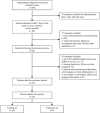Integrating Neutrophil-To-Albumin Ratio and Triglycerides: A Novel Indicator for Predicting Spontaneous Hemorrhagic Transformation in Acute Ischemic Stroke Patients
- PMID: 39690502
- PMCID: PMC11652394
- DOI: 10.1111/cns.70133
Integrating Neutrophil-To-Albumin Ratio and Triglycerides: A Novel Indicator for Predicting Spontaneous Hemorrhagic Transformation in Acute Ischemic Stroke Patients
Abstract
Background: Hemorrhagic transformation (HT) is a tragic complication of acute ischemic stroke (AIS), with spontaneous HT (sHT) occurring even without reperfusion therapies. Despite evidence suggesting that several inflammation biomarkers are closely related to HT, its utility in sHT risk stratification remains unclear. This study aimed to identify and integrate effective inflammatory biomarkers associated with sHT and to develop a novel nomogram model for the early detection of sHT.
Methods: We conducted a retrospective observational cohort study of AIS patients receiving conventional medical treatment solely from March 2022 to March 2023, using a prospectively maintained database. All patients underwent CT follow-up within 7 days after admission, with sHT occurrence within this period as the outcome. Data on demographics, clinical information, laboratory results, and imaging were collected. The cohort was divided into training and validation sets (7:3). Least absolute shrinkage and selection operator (LASSO) regression selected inflammatory biomarkers for a novel index. Univariable and multivariable logistic regressions were conducted to identify independent sHT risk factors. Receiver operating characteristic (ROC) analysis determined optimal cut-off values for continuous factors. A nomogram was developed and validated internally and externally. Predictive accuracy was assessed using the area under the ROC curve (AUC) and calibration plots. Decision curve analysis (DCA) evaluated clinical usefulness.
Results: Of 803 AIS patients, 325 were included in the final analysis. sHT was found in 9.5% (31 patients). Training (n = 228) and validation (n = 97) cohorts showed no significant demographic or clinical differences. LASSO regression integrated neutrophil-to-albumin ratio (NAR) and triglycerides (TGs) into a novel index-NATG. Independent sHT risk factors included baseline National Institute of Health Stroke Scale (NIHSS) (OR = 1.09, 95% CI (1.02, 1.16), p = 0.0095), NATG (OR = 1534.87, 95% CI (5.02, 469638.44), p = 0.0120), D-dimer (DD) (OR = 1.12, 95% CI (1.01, 1.25), p = 0.0249), and total cholesterol (TC) (OR = 1.01, 95% CI (1.00, 1.01), p = 0.0280), with their respective optimal cut-off values being 13, 0.059, 0.86, and 3.6. These factors were used to develop the nomogram in the training cohort, which achieved an AUC of 0.804 (95% CI, 0.643-0.918) in the training cohort and 0.713 (95% CI, 0.499-0.868) in the validation cohort, demonstrating consistent calibration. DCA confirmed the nomogram's clinical applicability in both cohorts.
Conclusions: A novel indicator combining NAR and TG is positively associated with sHT in AIS patients. The constructed nomogram, integrating this novel indicator with other risk factors, provides a valuable tool for identifying sHT risk, aiding in clinical decision-making.
Keywords: AIS; NAR; NATG; spontaneous hemorrhagic transformation (sHT); triglycerides (TGs).
© 2024 The Author(s). CNS Neuroscience & Therapeutics published by John Wiley & Sons Ltd.
Conflict of interest statement
The authors declare no conflicts of interest.
Figures




Similar articles
-
Nomogram established on account of Lasso-logistic regression for predicting hemorrhagic transformation in patients with acute ischemic stroke after endovascular thrombectomy.Clin Neurol Neurosurg. 2024 Aug;243:108389. doi: 10.1016/j.clineuro.2024.108389. Epub 2024 Jun 10. Clin Neurol Neurosurg. 2024. PMID: 38870670
-
Comparison of Two Modern Survival Prediction Tools, SORG-MLA and METSSS, in Patients With Symptomatic Long-bone Metastases Who Underwent Local Treatment With Surgery Followed by Radiotherapy and With Radiotherapy Alone.Clin Orthop Relat Res. 2024 Dec 1;482(12):2193-2208. doi: 10.1097/CORR.0000000000003185. Epub 2024 Jul 23. Clin Orthop Relat Res. 2024. PMID: 39051924
-
A predictive clinical-radiomics nomogram for early diagnosis of mesenteric arterial embolism based on non-contrast CT and biomarkers.Abdom Radiol (NY). 2025 Aug;50(8):3856-3867. doi: 10.1007/s00261-024-04745-3. Epub 2025 Jan 15. Abdom Radiol (NY). 2025. PMID: 39815026
-
Clinical symptoms, signs and tests for identification of impending and current water-loss dehydration in older people.Cochrane Database Syst Rev. 2015 Apr 30;2015(4):CD009647. doi: 10.1002/14651858.CD009647.pub2. Cochrane Database Syst Rev. 2015. PMID: 25924806 Free PMC article.
-
Signs and symptoms to determine if a patient presenting in primary care or hospital outpatient settings has COVID-19.Cochrane Database Syst Rev. 2022 May 20;5(5):CD013665. doi: 10.1002/14651858.CD013665.pub3. Cochrane Database Syst Rev. 2022. PMID: 35593186 Free PMC article.
Cited by
-
Immunoinflammatory biomarkers as predictors of hemorrhagic transformation in acute ischemic stroke patients after endovascular thrombectomy.Front Neurol. 2025 Jun 13;16:1606563. doi: 10.3389/fneur.2025.1606563. eCollection 2025. Front Neurol. 2025. PMID: 40584526 Free PMC article.
-
Early Predictive Accuracy of Machine Learning for Hemorrhagic Transformation in Acute Ischemic Stroke: Systematic Review and Meta-Analysis.J Med Internet Res. 2025 May 23;27:e71654. doi: 10.2196/71654. J Med Internet Res. 2025. PMID: 40408765 Free PMC article. Review.
-
Neutrophil-to-albumin ratio for predicting mortality in chronic kidney diseases: A cohort study on all-cause and cardiovascular mortality from NHANES 1999 to 2018.Medicine (Baltimore). 2025 Aug 8;104(32):e43666. doi: 10.1097/MD.0000000000043666. Medicine (Baltimore). 2025. PMID: 40797423 Free PMC article.
References
-
- Sun J., Meng D., Liu Z., et al., “Neutrophil to Lymphocyte Ratio Is a Therapeutic Biomarker for Spontaneous Hemorrhagic Transformation,” Neurotoxicity Research 38 (2020): 219–227. - PubMed
-
- Lindley R. I., Wardlaw J. M., Sandercock P. A. G., et al., “Frequency and Risk Factors for Spontaneous Hemorrhagic Transformation of Cerebral Infarction,” Journal of Stroke and Cerebrovascular Diseases 13, no. 6 (2004): 235–246. - PubMed
-
- Chen G., Wang A., Zhao X., et al., “Frequency and Risk Factors of Spontaneous Hemorrhagic Transformation Following Ischemic Stroke on the Initial Brain CT or MRI: Data From the China National Stroke Registry (CNSR),” Neurological Research 38, no. 6 (2016): 538–544. - PubMed
-
- Bagoly Z., “Hemorrhagic Transformation After Acute Ischemic Stroke Thrombolysis Treatment: Navigating the Landscape of Hemostasis Genetic Risk Factors,” Journal of Thrombosis and Haemostasis 22, no. 4 (2024): 919–921. - PubMed
Publication types
MeSH terms
Substances
Grants and funding
LinkOut - more resources
Full Text Sources
Medical
Miscellaneous

